Ghosts in the Lens
Following her graduation from Chelsea College of Art and Design in 2004, Lieko Shiga has started to show the three series of photographic work she made during the five years she lived in London—‘Jacques saw me tomorrow morning’ (2003–04), ‘Damien Court’ (2004–05) and ‘Lilly’ (2005). In 2006, she was extensively involved in projects organized for the Australia-Japan Year of Exchange, taking part in two six-month artist residencies in Brisbane and Sendai. The body of work she made during these residencies, later titled ‘Canary’, was shown at the exhibitions “Rapt! 20 Contemporary Artists from Japan”, organized by the Japan Foundation and held at a number of galleries and museums in Australia, and “Re: search, Art Collaboration between Australia and Japan” held at the Sendai Mediatheque.
This year, the three series she made in London were compiled into a book titled ‘Lilly’, and her new works from Brisbane and Sendai have been published in a book titled ‘Canary’, both of which won her the 33rd Ihei Kimura Photography Prize in April. Last month, her work was shown at Tokyo Opera City Art Gallery in the exhibition “Trace Elements: Spirit and Memory in Japanese and Australian Photomedia”, and it can currently be seen at the Tokyo Metropolitan Museum of Photography in “On Your Body”, which runs until December 7.

You lived in London for a long time. What made you decide to leave Japan for England?
At the time that I started taking photographs, someone suggested to me that I try to expand my horizons, and that led me to travel to Europe by myself. It was just a two-day trip to London, but while I was visiting museums and galleries, I saw a whole range of art, including photography, and I realized that there were art colleges where you could study photography within the broader context of art. I had already been studying at a Japanese photography school, but I found their way of talking about photography to be so constrained that I had to give up. It was my sense of regret about that, coupled with finding out about schools in London, that inspired me to move there.
You studied at Chelsea College of Art and Design but you actually made most of your work in your studio at home, first in Battersea, then in East London. What made you choose your own apartment over the studios in college as the space in which you make your work?
Art school was a great place for meeting all sorts of people and doing all sorts of things—a place for stimulation—but there were no studios where you could be completely on your own, and I didn’t feel this worked well for me. The process of making work while surrounded by everybody else’s work is fairly different from the the process of looking at yourself in a more introspective way, and that was what I felt suited me better. This separation between making my work at home and then bringing it into school to show people and discuss it with them during crit sessions definitely worked out better for me.
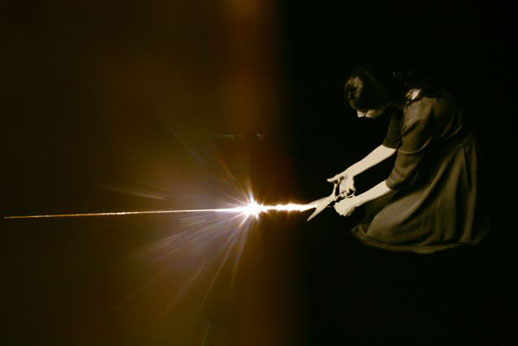
How did being in London affect the way your practice?
I was unable to communicate with people, and the effects of that show in my work up until the ‘Lilly’ series. In other words, it was very easy for me to be alone when I wanted. I came to know and think about what it was to find yourself here and now, alone, in a place you don’t understand. In Japan, I had my family and friends close by, but in my first year at university in London I didn’t have a good grasp of English, so I became very introverted. There were times when I would be confused—for example when I would take someone’s comment at face value without realizing it was an English-style sarcastic joke. For reasons like that, I still find England quite a tough place to be. It takes time to truly integrate; it feels as though there is a bit of a gulf between yourself and other people, that everyone there is very individualistic. In one sense that is a real form of maturity, but I wasn’t able to adjust to that kind of maturity—at least, not at first. So I really delved into some dark, solitary introspection. Perhaps it was through that experience that I explored my relationship with the subjects of my photographs, and I developed my technique of taking a photograph and then rephotographing the print so as to turn the subject into a completely fictional being.
Who are the people in your work? How do you meet them?
They are all people who were in my immediate surroundings: people I lived with, friends, and later people I met on the street—in short, people I had easy access to. I would sit on the pavement, waiting, and then approach people. It was a bit of a haphazard way of communicating, though.
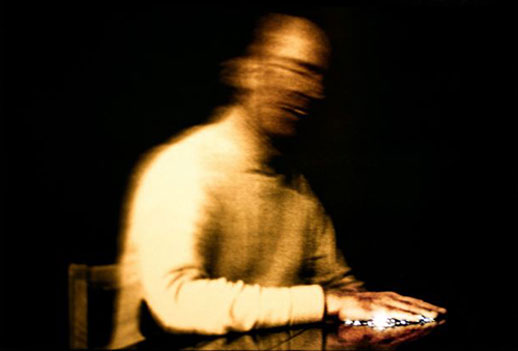
The first major set of work you made in London was ‘Jacques saw me tomorrow morning’. Who was Jacques and what was the story there?
Well, I think you already know this story quite well! [laughs] Jacques was my flatmate. We were from different countries, were of different sexes, different generations, different personalities, different genders. My works about him drew on the surprise of living with a stranger in the same house. He felt just like a ghost to me. I had no idea what he was up to during the day; just the very fact that we were living in the same house was incredibly mysterious, at times even frightening. I think that getting him to pose for me was my way of getting to know him little by little.

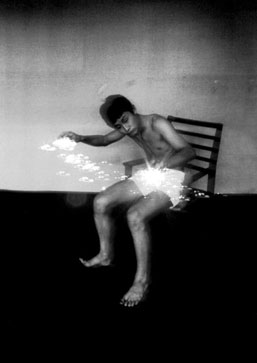
Your work has changed a lot since I first met you. At first, your images, like ‘Piano’ (1999), were very playful, lighthearted and fantastical. But gradually after the ‘Jacques saw me tomorrow morning’ series, in the ‘Damien Court’ and ‘Lilly’ series you seemed to pick up on a sense of social unease in London. You were starting to connect with the people you photographed in a different way. How did things change for you?
At a fundamental level, nothing changed. Beyond that, there were two changes: the technique I used, and my way of relating to people. At first I used to approach the people in my immediate surroundings, but because I was making those choices according to personal preferences, everything I did was within a certain scope of preconceived ideas. So, gradually I started to create frameworks to operate in. For example, I would decide I absolutely had to photograph every single person in my apartment building, and by forcing myself to include everyone I was hoping that such contrived communication would lead to unexpected developments. In other words, the addition of an element of obligation was one way in which the construction of my work changed. That kind of communication and process led me to become more involved with people I didn’t know. It was no longer just about my friends and the people I lived with, but Mr ‘such-and-such’ living on the 3rd floor—people whose faces I had barely seen and yet I told myself I absolutely had to photograph them. That was even more frightening than what I had experienced before, but it was a very important experience. Jacques was my flatmate, so at some level there was always a sense of ease. My earlier work has a sense of softness and flexibility to it, whereas in the subsequent ‘Damien Court’ and ‘Lilly’ series there is a stronger sense of fear, the sense of coldness you get from strangers, and the understandable sense of fear and tension that those people felt when I asked them to sit for the photographs.
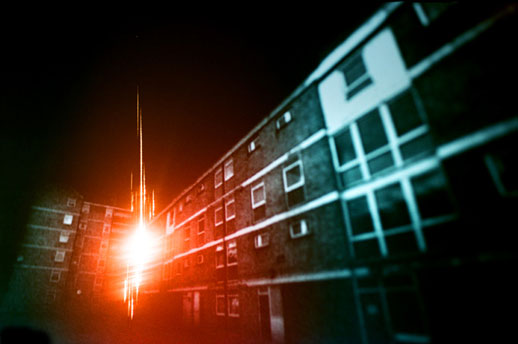
After London, you took part in residencies in Sendai and Brisbane. How did you connect with people there?
Going to Sendai was for a project, meaning that it was the first opportunity I had to leave the realm of my everyday life as a university student and venture into the outside world. I went to Sendai solely with the aim of making work. By that I mean residency organisers have already established the concept and the guidelines, so doing a residency can feel like a kind of job. For that reason, I had to make the most of my situation and make my work while consciously delving deep into a variety of different forms of communication.
Firstly, in order to familiarize myself with these places I didn’t know, I distributed a questionnaire to the local residents. I wanted to explore their personal memories of these cities, so I asked them to identify their “brightest” and “darkest” spots within the city. Once I had all the details of these locations, I plotted them out on a map and used that to go around the city on a location hunt. This led me to make connections with people and develop work out of those connections. There were some straightforward photos, but almost all of them employed constructed set-ups. That was another point that made this series of work different from ‘Lilly.’ In terms of my photographic methodology the act of taking photos became more and more public, and the surroundings became an integral part of the images too. I was very pleased with the final results.
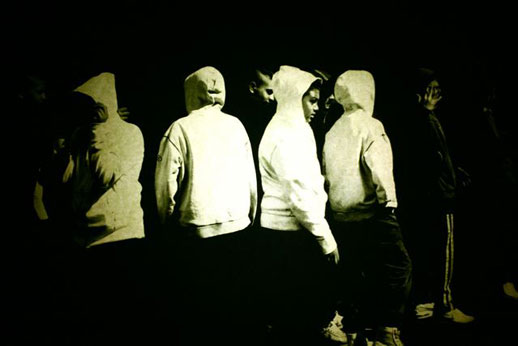
The work you made before those residencies had black backgrounds and the focus was on people floating within that space, but now you are increasingly exploring the locations themselves, which often show no trace of human presence. Some of these settings are very unusual and mysterious. How do you find these places and what is it that compels you to photograph them?
The particularities of the places are not all that important. Rather, I will go through a variety of processes that end up leading me to a location, and it’s the experiences I have along the way that matter. I think those experiences have a profound connection with the history and societies of those places.
What’s the relationship between the preconception you have of the image in your mind before you take the photo and the reality of taking it?
At the initial stages of setting up the scenario for a photograph I have a certain image in my mind, but it’s only a starting point. For example, I’ll have some kind of narrative in my mind like “someone will be a bit like this, and it will turn out this way”, and then I cancel that out and move to the next stage, which is a kind of “action”. How the person being photographed reacts to the site where the photograph is being taken is also something like an improvised performance. The subject’s action, my own action, or the action of time, become mixed together and I wait for something unexpected to happen on site.
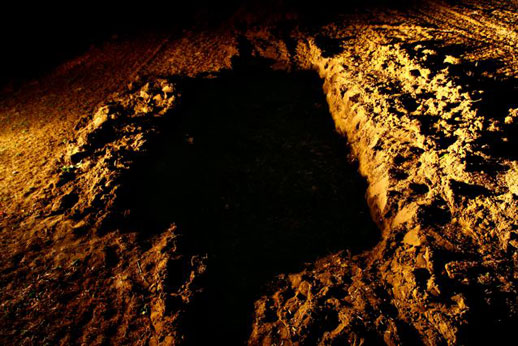
For example, with Flower Hole, I visited a location where a Buddhist service being held—somewhere that had been referred to a “bright” spot in someone’s questionnaire. It was a very intense place, and I listened to the people from the temple tell their stories. They told me that after the ceremony they throw away the large mass of flowers they accumulate, so I asked them to give them to me. I eventually dug a hole on a mountain and buried them there, but I had never decided at what point in that process I would take the photo. Eventually the set-up of the photo became a kind of “flower grave”, and the moment I decided to take the photo was when the hole was empty. In that case, that was the moment of unpredictability. The scenarios I create for my work are a means to instigate moments of unpredictability.
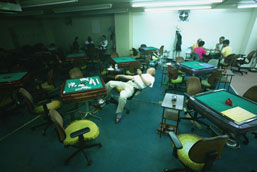

Some of your works have very unusual phenomena in them. Do you achieve these effects using manual or digital techniques? Do you use Photoshop?
I have only ever used Photoshop once, in one image, Bon Bon Hall, in the ‘Canary’ series. There was a support propping up the man’s chair and I Photoshopped it out. Apart from that one time, I have never used it. Within the sixty photos in the ‘Canary’ series, there are about ten that are retakes of original photographs. ‘Canary’ was the first series I took using a digital camera, although I continued to use a manual lens. The photo comes up on screen immediately, which helps reassure the person being photographed. Sometimes they get interested in it and make suggestions, which helps improve the communication taking place in the photo shoot.
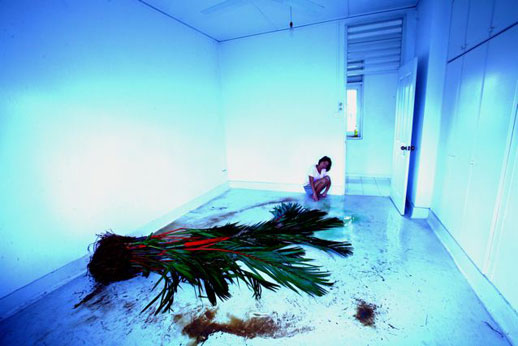
Can you tell me about the two books you published?
‘Canary’ is a book of my new works, and ‘Lilly’ features my older works. The ‘Lilly’ series was a huge body of work that I made over a five-year period. From within that I chose a hundred photos, dug out the original negatives and remade them, so there will be a lot of images in there that you haven’t seen before. The ‘Canary’ works were all made within the past year, so they are very fresh. These images are extremely raw and they all exceeded my expectations. I still haven’t figured out the meaning of many of them yet. As for how I communicated with people to make these works, it was like being swallowed up in a whirlpool. The ‘Lilly’ series was made from a relatively external point of view, by looking at things objectively, but when I made ‘Canary’ it felt as though I was inside the work. So I’m happy to have seen that difference between the two series emerge.
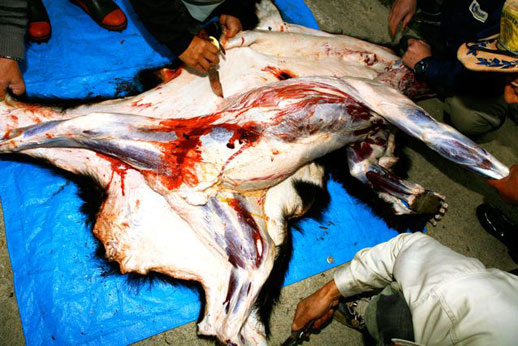
There are also themes of life and death, as well as a strong undercurrent of sexuality, that seemed to emerge out of the work you made in Brisbane. Was this an influence you specifically got from being in Australia?
The Australian land itself is already somehow imbued with this feeling of life and death. There is so much there that is more powerful than humankind: the sun, the ground, the wind, the wildlife. It feels like humans are an insignificant presence there. In that sense, humans can never win; they are always surrounded by a more powerful life force. Walking around the outskirts of Australian cities, you frequently come across the dried out bones of animals. You don’t find that kind of thing in the city centre. In that sense I was very strongly conscious of the physicality of my surroundings. This lifestyle, in which you are unconsciously aware of death being close to you, and that you’re not protected from it, was a very intense experience for me.
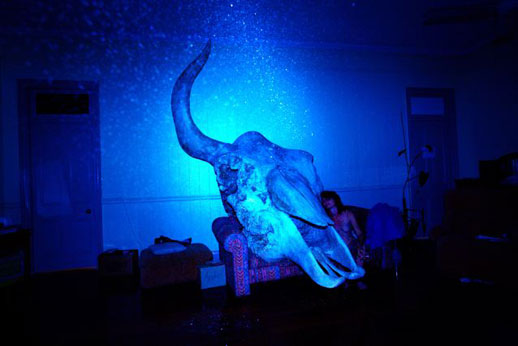
The giant skull in My Husband is a particularly striking example of this new focus on mortality. In fact, since you make your works without the use of digital effects, can you tell us how on earth you made that skull?
In Australia, the sun bleaches the bones of dead animals; I would get the feeling that the sunlight is so strong that it could go even further than tanning the skin, and burn directly through to the bones, turning them white in an instant. When I was doing preparatory research for this series, I went to the natural science museum and saw a lot of animal skulls, which you keep finding on the sides of roads in Australia. The skull in My Husband is a cross between a human skull and the skulls of various different species of mammal that live in Australia—so it’s a work of fiction. I made its base out of polystyrene and shaped it out of plaster.
So in order to realise this photograph, you temporarily ventured into the realm of making sculpture.
I wasn’t conscious of it at the time, but it was the first time I had taken a knife to a block of polystyrene, and not knowing how to do it, it was hard work. But the skull gradually took shape and through the act of carving I felt like I was somehow pouring my own soul into the work. Being unused to this technique, it was a clumsy and unskillful process, but I think that was a good thing.
As you mentioned before, the set-ups and processes that lead up to the moment when you take the initial photo are like a performance or ‘action’. Once you press the shutter, do you feel that you have captured a heightened state of reality?
I think ‘action’ in photography is something to do with that sense of freshness: the photo shoot for My Husband in particular felt new and fresh to me. But the planning of the photo shoot is something I constructed. It’s all a fabrication. So it’s the realization of a lie—well, if not a lie, then something like an inversion or a paradox.
My photographs render everything into reality: they are a way of bringing something back to life. You can talk about photographs in terms of ‘shooting’—to ‘shoot’ with a camera like you would shoot with a gun. However, for me, taking photos is not like shooting something: it’s like being shot. I am shot, and the entire timeline of my existence is resurrected in the photograph. So, I think photography is the revival of eternal time and eternal life; a photograph is not a representation of time that has been killed. In such conditions, that means that I myself am firmly embedded in the photograph.
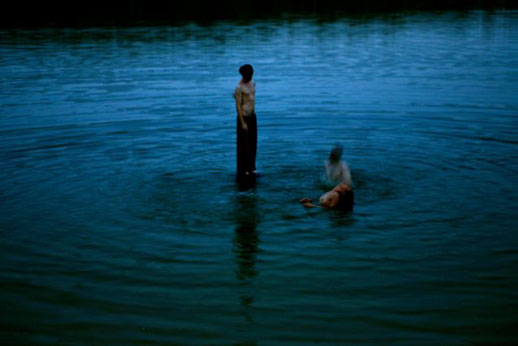
You have just spent the last year back in England, on a Japanese government scholarship. What did you do there?
I took a look at each of the photographs in the ‘Canary’ series and considered them in terms of language. Each of those images is tied up in a whole variety of different social contexts and narratives, so I felt that if I didn’t make the effort to understand and interpret all those facts, then I wouldn’t be able to make any progress. I spent many days in the British Library, reading books from Japan for my research.
Now that you are back in Japan, what are you planning to work on?
I’m moving to Miyagi Prefecture to get ready to start work on my new photographs. These new works will be an experiment in going even deeper than what I was doing with ‘Canary’—I want to go right into the depths of historical and social contexts.
(Translation: Ashley Rawlings)
Ashley Rawlings
Ashley Rawlings



